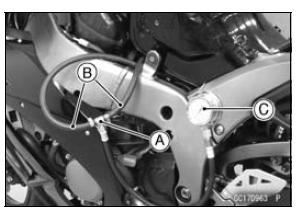

NOTE
Be sure the battery is fully charged.
Be sure to place a piece of cloth around the fuel outlet pipe of the fuel pump and the delivery pipe of the throttle body assy.
| WARNING Fuel is flammable and explosive under certain conditions and can cause severe burns. Be prepared for fuel spillage; any spilled fuel must be completely wiped up immediately. When the fuel hose is disconnected, fuel spills out from the hose and the pipe because of residual pressure. Cover the hose connection with a piece of clean cloth to prevent fuel spillage. |
Special Tools - Oil Pressure Gauge, 5 kgf/cm²: 57001-125
Fuel Pressure Gauge Adapter: 57001-1593
Fuel Hose: 57001-1607

| WARNING Fuel is extremely flammable and can be explosive under certain conditions resulting in serious injury or death. Do not try to start the engine with the fuel hoses disconnected. |
The fuel pump should operate for 3 seconds, and then should stop.
NOTE
After turning on the engine stop switch and ignition switch, inspect the fuel leakage from the connected portion of the special tools.
NOTICE
Do not drive the fuel pump 3 seconds or more without the fuel in the fuel tank. If the fuel pump is driven without the fuel, it may be damaged.
Fuel Pressure (with Engine Idling) Standard: 294 kPa (3.0 kgf/cm², 43 psi)
NOTE
The gauge needle will fluctuate. Read the pressure at the average of the maximum and minimum indications.
Turn the ignition switch to OFF.
Fuel Line Leakage (see Fuel Injector Fuel Line Inspection) Amount of Fuel Flow (see Fuel Flow Rate Inspection)
After above checks, measure the fuel pressure again.
Remove the fuel pressure gauge, hoses and adapter.
Install the removed parts (see appropriate chapters).
Start the engine and check for fuel leakage.
 Fuel Line
Fuel Line Fuel Flow Rate Inspection
Fuel Flow Rate InspectionRear Master Cylinder Removal
Unscrew the brake hose banjo bolt [A] and remove the
brake hose (see Brake Hose and Pipe Replacement in
the Periodic Maintenance chapter).
Remove:
Rear Master Cylinder Mounting Bolts [B]
Foot Guard [C]
Screw and Stopper [D]
Bolt [E]
Front Footpeg Bracket Bolts [F]
Cable Guide [G ...
Transmission Shaft Disassembly
Remove the transmission shafts (see Transmission Shaft
Removal).
Remove the circlips, and then disassemble the transmission
shafts.
Special Tool - Outside Circlip Pliers: 57001-144
The 5th gear [A] on the output shaft has three steel balls
assembled into it for the positive neutral fin ...
Muffler Body Installation
Replace the muffler body gasket [A] with a new one.
Install the muffler body gasket to the premuffler chamber
[B] until it is bottomed so that the chamfer side faces premuffler
chamber.
Install the muffler body clamp [C] as shown in the figure.
Insert the projection [D] into the slot [ ...